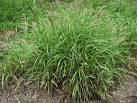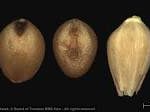Cenchrus biflorus
Uses
India (Rajasthan, western): seeds eaten mixed with Bajra (millet) for bread making. Seeds used for making bread, especially in Marwar. Seeds also eaten raw. Sudan (Kordofan, Darfur): seeds removed from husks by rubbing spikes between two pieces of leather. Seeds are pounded and eaten raw or made into porridge. They can also be mixed with other foods. A thin bread (Kisra) is also made from the seeds. Nigeria (Kano State, northern): seeds eaten. Rare in northern Kano Niger (southeastern): seeds eaten.
Partial nutrient data (Niger sample)):Protein = 24.0%, Mn = 12.97mcgg/g Fe = 95.01mcg’/g Ca = 224mcg/g Mg = 638mcg/g Cu = 5.79mcg/g Z’n = 48.73mcg/g
Additional Information
- Name Authority:
- Roxb.
- Vernaculars:
- India: Bhurat /Bhurut. Sudan: Haskaneet/'Askanit. Nigeria (Hausa): Karangiya. Kanuri: Ngibbi. Niger (Hausa): karengiya.
- Misc:
- Soil types favored by plant: sand dunes, sandy plains. Chemical composition (Sudan sample): Sulphur = 0.20% (dry). Potassium = 0.18% - Magnesium = 0.7% (dry). Calcium = 0.07% (dry). Na = 0.01% (dry). K = 0.17% (dry). Zinc = 52mg/kg-1 (dry). Iron = 71mg/kg-1 (dry). Manganese = 22mg/kg-1 (dry). Copper = 5mg/kg-1 (dry). Aluminum = 124mg/kg-1 (dry). Fatty acids (saturated): 14:0 = <0.1g/100g-1. 16:0 = 23.8. 18:0 = 4.0. 22:0 = <0.1g/100g-1. 24:0 = <0.1g/100g-1; (monosaturated): 16:1 = 3.0. 18:1 = 30.2. 20.1 = <0.1g/100g-1; (polyunsaturated): 18.2 = 35.7. 18:3 = 1.9.




